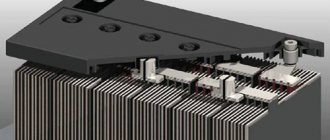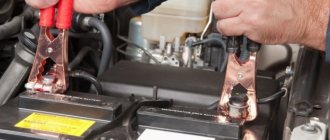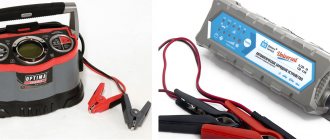Causes of battery failure
Before restoring a car battery with your own hands, the causes of the breakdown are studied.
Capacity is lost for several reasons:
- Formation of lead sulfate. This kind of problem occurs all the time. Damage to batteries can be determined by loss of charge.
- Failure of the can that is part of the power source. Occurs due to a short circuit that occurs between the lead plates. With subsequent use, the electrolytic composition begins to boil and the capacity drops.
- Destruction of lead plates. Residues enter the electrolytic composition and change its properties. In these cases, the battery is not restored.
- Freezing of the electrolytic composition. Some batteries are filled with a substance that has a high density. At negative temperatures, the composition freezes and the casing is destroyed. It is impossible to revive the battery with your own hands.
Based on the above, we can conclude that the malfunction of the battery occurs due to improper operation of the power source.
Signs of wear
To understand that the battery will soon fail, you need to have some information - find out the main signs. Without the necessary knowledge, restoring car batteries will be difficult. You will need to carefully monitor your car. Only in this case will it be possible to take the necessary repair measures, in particular the battery, in a timely manner.
There are several main signs:
- If the battery quickly loses its charge, then you need to worry. This is the first sign of a decrease in the quality of the electrolyte poured inside.
- Another sure sign of a battery malfunction is very fast charging through a special device. The reason for this will be sulfation, which has already begun.
- The electrolyte has darkened. If the substance begins to darken, then it is necessary to immediately begin restoring the battery, because this is one of the main signs that the carbon plates are beginning to crumble and deteriorate.
- If individual sections of the battery heat up or the electrolyte boils, this is due to the plates being shorted or damaged. The main reason for this malfunction is that the car sits idle for a long time in extreme cold. The plates may freeze and the body of the device may become covered with ice. As a result, a short circuit will appear, which, in turn, will lead to very rapid boiling when charging the electrolyte. This malfunction is already very serious, and in most cases it will not be possible to resurrect the device.
The battery can be restored in almost all cases if it is completely neglected. The operation can be quite expensive, but the money will be spent much less than when purchasing a new unit.
You need to be careful when using the battery and immediately notice various problems. The life expectancy of the battery will depend on this. Before you begin to directly restore the car, you need to find out which parts of the battery are generally subject to resuscitation.
Electrolyte density
The electrolyte is poured into the battery .
Usually this substance is a kind of cocktail of acid and water. If the battery is nickel-cadmium or nickel-iron, then in this case an alkaline electrolyte is poured inside. We recommend: What to do if your car battery runs out quickly Before you start repairing the battery, you need to know exactly the density of the electrolyte. To do this, use a device called a hydrometer. You don’t have to spend a lot of money to buy it; it is sold in absolutely any auto parts store. You can also use a voltmeter to measure the density of the acid solution. The equipment must be turned off to the vehicle terminals.
When turned off, the numbers should be approximately 11.9-12.5 V. After this, turn on the car, pick up 2500 revolutions and take the measurement again. If the voltage is 13.9-14.4 volts, then the density is within normal limits. In this case, the old battery only needs to be recharged. But if the indicators are too low, a restoration will be required.
Several ways to perform resuscitation:
- Using a battery charger and bringing the charge to 100%. You can't lose charge.
- Complete replacement of the battery solution with a new one.
- Use of high-density electrolyte.
- Adding only sulfuric acid.
- Adding only water.
Before restoring the acid solution, it is worth trying to simply recharge the equipment. Sometimes it happens that after such a simple procedure all problems disappear.
If problems with the electrolyte appear after charging, then it is necessary to change the density of the solution in the battery.
Under no circumstances should water be poured into sulfuric acid . It is very important. Otherwise, you can get very serious skin damage in the form of burns. The water will boil and splash out in different directions. Restoring a car battery must be done carefully.
Destruction and short circuits of plates
If the plates on the battery have broken down or are just beginning to break down, then it is necessary to immediately take restoration measures. If the battery is significantly damaged, then it will no longer be possible to restore its parts.
That is why before resuscitation, you need to make sure that this is not a useless exercise. The process of destruction can only be stopped if it has just begun. There is no point in reviving a fairly battered device.
If you find signs of destruction, you should immediately wash the jars:
- First, you need to completely discharge the device by connecting any load to the battery. For this purpose, a regular light bulb is usually used.
- All damaged solution is removed from the jars. To do this, use a rubber bulb. The solution is placed in a glass container that has been previously prepared.
- The jars are washed with distilled water until completely clean. When cleaning the battery, it is necessary to constantly turn it over and shake it.
- If there is a lot of dirt inside, and coal crumbs are still pouring out, then the process is already irreversible, since it has gone far. In this case, the battery can no longer be restored.
- When complete cleanliness has been achieved, a new solution must be placed in the jar. Before this, the density of the substance must be checked.
- The battery is charged so that the previous voltage returns to the desired level.
When the cleaning operation is completed and the device is fully charged, you need to check the electrolyte and its density again. If necessary, the indicators will have to be brought back to normal.
Diagnostics of sulfation
Sulfation is one of the most common battery problems. Under normal operating conditions, certain processes occur in the battery during discharging and charging. But when the car starts infrequently, the processes will be disrupted.
We recommend: Varta silver dynamic car battery
Lead sulfate crystals may appear on the plates. They are difficult to remove and can lead to the following consequences:
- Battery capacity decreases.
- Internal resistance increases.
- The volume of the plates increases.
In most cases, sulfation begins to appear if the car sits for a long time without use, overheats, or is exposed to critical current conditions. You can understand that sulfation has begun by seeing a drop in charge.
To determine this indicator, you need to use a tester. If a defect is found, you need to think about ways to restore the battery in the near future. You need to act quickly while the device still has the opportunity to be restored. To restore it, it is necessary to use a special electrolyte additive. A desulfator is usually used to dissolve the crystals that have formed. These were the main problems. After studying them, you can learn how to reanimate a car battery at home.
Effective ways to restore a car battery
Knowing how to restore a car battery on your own can help you get rid of many problems.
Desulfation of lead plates
In lead-acid power supplies, when energy is absorbed, crystals are formed that include lead sulfate. With constant use, sulfation has virtually no effect on battery performance. Another dependence can be traced:
- A small discharge results in the appearance of small crystals. They dissolve quite quickly in the electrolytic composition.
- After a deep discharge, large sulfates are formed. They are not destroyed.
Cleaning lead plates is done:
By physical means
The car battery can be dismantled at home. After this, the plates are removed and cleaned. To simplify the removal process, holes are formed in the lid. For these purposes, use a soldering iron, which makes it easier to carry out the work.
Hand-cleaned plates are washed. For this purpose, distilled water is used. It is also necessary for washing the inside of the jar. After all, flushing the battery helps restore performance.
After this, the plates are placed back and filled with an electrolytic composition. The battery is being charged.
This method is difficult to implement, since the integrity of the plates is easy to damage.
Chemically
For cleaning, use a solution containing active substances. Restoring the battery chemically requires 1–3 hours. But before implementation, preparation of the substance is required.
Power supplies are restored in stages:
- Battery is fully charged.
- Draining the electrolytic composition.
- Cleaning and washing the car battery. For these purposes, distilled water is used.
- The solution is poured for 1–2 hours. This time is enough for the sulfates to dissolve. Gases are released during the process.
- Re-washing the battery is important. After all, it is necessary to remove the remaining sulfate from the inside of the case.
- Filling the electrolytic composition with the required characteristics.
- Recharge the power supply.
During chemical cleaning, there is a possibility of lead getting into the jars, between the plates. This often provokes a short circuit.
Basic battery problems
The positive and negative plates of the battery are placed in a closed plastic container, into which the electrolyte, which is a solution of hydrochloric acid, is poured. Together with the lead plates it forms a so-called galvanic couple. The terminals receive current from the generator or charger. When it accumulates in sufficient quantities, the battery itself turns into a source of electricity.
Losses of electricity spent on start-up and other needs are replenished using a generator. However, after a certain time, the accumulated reserves become insufficient for normal operation. During operation, the plates become aging. In some cases, the battery can be revived. But to do this, you first need to accurately determine the cause of the non-working condition of the battery in order to restore the car battery at home.
Most often, the battery fails due to sulfation of the lead electrodes. In the case of deep discharge, the crystals do not have time to dissolve. In addition, sulfation occurs due to regular undercharging and prolonged storage of the battery in a state of complete discharge. It is easily determined visually; just unscrew the plugs and look at the plates, covered with a light brown coating.
In other cases, in the presence of sulfation, the battery begins to boil quickly when charging; when fully charged, it does not rotate the starter motor and dies within a few minutes even under the slightest load. The body becomes covered with a white coating and returning to its original state is already problematic.
Another well-known cause of battery failure is the destruction of the plates and their further shedding. The main external sign is the black color of the electrolyte. If many grids are destroyed, repairing such a battery becomes impossible and it can no longer be restored.
Resuscitation using a charger
How to restore an old battery yourself? Chargers can be used. But this method takes a lot of time and effort. After all, alternating discharge and charge of the battery is required. This leads to the gradual dissolution of lead sulfates.
Before sale, check the level of electrolytic composition. Before charging, fill with electrolyte or distilled water, if necessary.
Restoration is performed with a regular or pulsed charge. When choosing an option, it is necessary to take into account the condition of the battery unit and the duration of its operation.
Pulse charging
To resuscitate a battery source, a charger is used, which is equipped with the following functions:
- Desulfation.
- Pulse charge.
Such a unit is connected to the car battery that you are trying to revive. The wires are first connected to the source. After this, the charger is connected to the network.
The charge is supplied for 9–10 minutes at low current. After this, the corresponding load is applied. This is enough for the power source to be completely discharged.
It is also possible to set other time intervals.
Pulse charge is used provided that the battery condition is normal. After all, the cost of such a device is quite high.
Using a standard memory
Resuscitation of the battery is also possible using a standard charger. Before you begin restoration, you need to clean the unit, remove any remaining oxide, and any leaks of the electrolytic composition.
Next, the following actions are performed:
- Charging the power supply at low currents for 9–10 hours. The current level decreases if the unit heats up excessively, the electrolytic composition boils. If everything is done correctly, the voltage increases slightly.
- The battery power supply is disconnected from charging. Leave at rest for 12–24 hours.
- Reconnection to the storage device. The current rises to 2.5A for 6–8 hours. This helps to increase the level of density of the electrolytic composition and increase the voltage.
- Discharging the power source to 8–9 V. To do this, connect a lamp to the device.
The measures are repeated until the optimal density is established, a voltage of 12–12.5 V.
Recharging the battery with a regular charge takes longer. But with its help, even old power supplies can be revived.
How to diagnose a car battery
Perform a diagnostic inspection. Mechanical damage often occurs under constant loads. Disconnect and remove the battery and inspect for cracks. Electrolytic fluid could leak through them, which caused the breakdown. Be sure to examine the lower part. If no cracks are observed, proceed to a more thorough diagnosis.
Electrolyte level
Look into the banks. It is important that the electrolyte level is below 1-2 from the cap.
If the level is significantly lower, the problem may be in the generator system. Sometimes it cannot cope with charging, which leads to the electrolyte boiling. Acid vapors pass through the breather holes.
Low levels are dangerous because they can lead to:
- Aging of the plate. A low level indicates a small amount of water due to its volatilization. This means that the level of sulfuric acid increases, which is detrimental to the plate. And this makes the defect faulty, since a chemical attack has occurred.
- Sulfation of platinum. The metal becomes covered with acid breakdown products, which subsequently leads to corrosion.
- I'll heat it up. The upper part of the metal is exposed. Reducing the liquid level causes local heating, which causes the mixture to boil.
- Capacity drop.
An increased level indicates the predominance of water. Inside the battery, the composition is in a clear balance: H2O – 65%, H₂SO₄ – 35%. An increased level of the former changes the physical properties of the mixture. Being balanced, it freezes at a temperature of -40 degrees. But with displacement, the indicator decreases and now freezing can occur at -20.
Electrolyte density
There is a tool for diagnostics - a hydrometer. Sold in automobile stores. The purpose of a hydrometer is to check the density of a liquid. For a battery, it should be from 1.2 to 1.31 grams per centimeter. If the indicator is lower, then the electrolyte is faulty and needs to be charged. If higher, there is a high probability of global breakdown.
In addition, low readings may indicate an internal short circuit. The value should be the same in all jars (±0.2 grams).
Battery level
To check functionality, you can use a load fork. The device is made simply: a voltmeter, a handle, a resistance switch and terminals.
You can use a multimeter and check the output voltage. In this case, you need to disconnect the negative contact.
If you are repairing a new car, inspect it for a charge indicator. This is a light bulb that lights up in different colors, depending on how charged it is.
Short circuit "banks" of the battery
Such a breakdown leads to irreversible consequences if measures are not taken in a timely manner. After all, the performance of undamaged “cans” gradually deteriorates, since they receive a huge current.
To restore the car battery, perform the following measures:
- Identifying a bank that has failed. During charging, the non-working element boils or does not function at all.
- The electrolytic composition is drained from the damaged can. Such actions are performed with rubber gloves. After all, when electrolyte comes into contact with the skin, a burn is formed.
- A hole is prepared through which the lead plates are removed. They are washed using distilled water.
- Determining the cause of the short circuit. In old batteries, the cause is sediment that accumulates at the bottom of the can. Therefore, you need to know how to rinse a jar.
- Lead plates are placed in a cleaned jar and electrolyte is poured.
- The formed hole is carefully sealed.
If all processes are carried out carefully, the power source is restored.
What batteries can be restored?
Not all batteries can be returned to working condition. Therefore, it is necessary to determine whether it is advisable to restore a given battery for a car. It is hardly worth dealing with a battery that has received serious mechanical damage or has been exposed to negative electrical power.
For a short or long period, it will be possible to bring back to life a battery that has become unusable due to sulfation.
It will not be possible to work with power sources whose plates have shed, since a short circuit will form inside the cans. Experts recommend immediately disposing of blocks whose body is swollen or shows obvious mechanical damage in the form of chips, cracks, or crevices.
Reanimation of a maintenance-free battery
Maintenance-free power supplies can also be restored. After all, it is prohibited to create a hole in the lid, as this will negatively affect the gas exhaust system.
The process of resuscitation of maintenance-free car batteries includes:
- Determination of the level of electrolytic composition. To do this, the body is illuminated with a lighting device.
- If there is a deficiency, a hole is prepared in the body. It should be slightly higher than the electrolytic composition level. The hole size is 2–4 mm.
- Filling with distilled water. This is done using a syringe.
- The hole can be closed using soldering.
The device's capacity is restored by discharging and charging. These processes are performed cyclically.
Restoring a helium power supply
Resuscitation of helium-type power supplies is simpler. After all, there is no need to prepare holes. Recovery includes the following actions:
- Removing the top cover.
- Carefully remove the rubber caps, which are located under the lid.
- Translucent cans that are included in the composition. Banks are considered functional if the insides are preserved. If rot or other contamination is detected, power supplies are not resuscitated.
- Distilled water (1-2 cubes) is added to each. After this, the source is sealed. This procedure is performed carefully to ensure tightness.
Restoring a helium battery is not carried out in the following cases:
- Complete destruction of lead plates. This may be the result of prolonged use of power supplies at elevated temperatures.
- Swollen power supply.
Common causes of battery failure
When the battery is subjected to frequent complete discharge and prolonged downtime in this position, then during such operation the main “disease” of the battery occurs - sulfation of the plates. The consequence of this process is a noticeable decrease in capacity. Because of this, such a battery cannot crank the starter when starting the engine.
Sulfation of battery plates
You can recognize the beginning of sulfation by several signs:
- increased voltage at the terminals;
- noticeable heating of the plates during operation;
- sometimes the electrolyte boils;
- charge capacity decreases.
Another cause of failure may be the destruction of the plates, which leads to a short circuit between them. Sometimes the plate is completely torn from its place. The reason for this damage may be an excess of voltage supplied to charge the battery when there is a lack of electrolyte in the container.
You need to know that both insufficient and overcharge can lead to the destruction of a car battery.
After carrying out repair work on the battery, in order to revive the car battery, it will be necessary to get rid of the source of destruction of the electrical element.
Resuscitation and distilled water
You can also revive a car battery using distilled water. This method takes 45–60 minutes to implement.
If the battery is completely drained, it must be charged before resuscitation. After this, the electrolytic composition is drained. To do this, screw the plugs that are concentrated on the lid.
The body and elements are washed with distilled water. After this, a special solution is poured in to perform desulfation.
The desulfation process is accompanied by the release of gas. Therefore, it is better to place the recovery source in the room in which the ventilation system operates.
Distilled water is used for cleaning. The washing procedure is performed 2–3 times. Only after this is the electrolytic composition, which has the required density, poured inside.
The restored power source is connected to the charger and the network.
This recovery method is easy to implement. Therefore, it can be used by beginners and experienced motorists. But the service life of a restored power supply is difficult to determine. It all depends on:
- Timely maintenance.
- Compliance with the terms of use.
- Frequency of use of vehicles.
For example, frequent use of a car battery in a discharged state makes it impossible to restore it.
The process of restoring a car power supply includes many aspects and rules. And whether you can revive the unit depends on how accurately they are implemented. Therefore, all steps must be performed in accordance with the recommendations of specialists.
How batteries work
A battery with a nominal voltage of twelve volts consists of (usually six) autonomous batteries (that is, cans) of lower voltage (two volts), which are collected in one housing and connected in series to each other.
Battery charger
- The battery housing is made of hard rubber or acid-resistant plastics. The case has compartments for mounting battery cells.
- The battery bank is a set of differently polarized plates, isolated from each other using acid-resistant separators.
- The pole plate has the form of a lattice and is made of lead. An active substance of a special composition and porous structure is pressed into the cells of this lattice in order to increase the contact area with the electrolyte. This substance is made from lead powder to which sulfuric acid is added. Barium sulfate is also added to the negative plates. During the formation of the battery, the plates are charged, and the active substance in the negative plates turns into spongy lead, and in the positive plates into lead dioxide.
- The electrolyte is designed to move charged particles and is poured into the battery banks. Made from distilled water and sulfuric acid.











